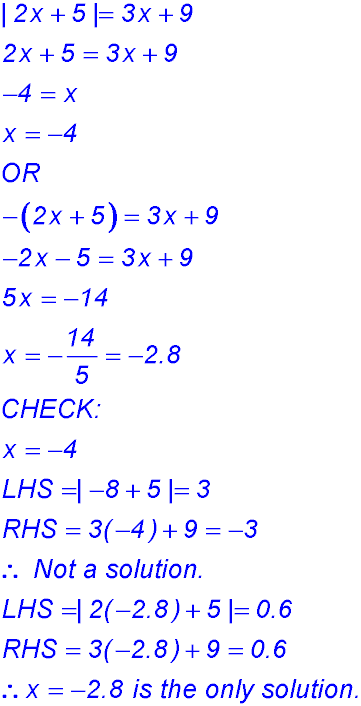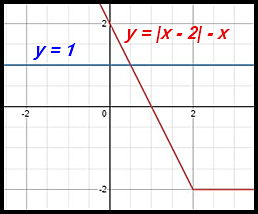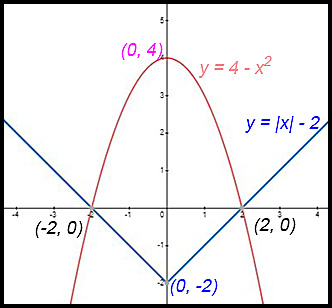Where the techniques of Maths
are explained in simple terms.
Algebra - Absolute values - linear equations.
Test Yourself 1 - Solutions.
- Algebra & Number
- Calculus
- Financial Maths
- Functions & Quadratics
- Geometry
- Measurement
- Networks & Graphs
- Probability & Statistics
- Trigonometry
- Maths & beyond
- Index
| Solve each of the following equations. | |||
| 1 term in x. | 1. t = +42 or - 42 | 2. 6t = + 24 or -24 t = +4 or t = -4 |
|
3. 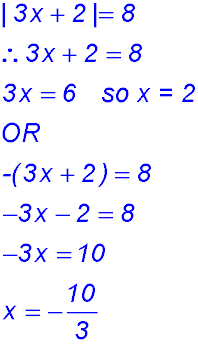 |
4. 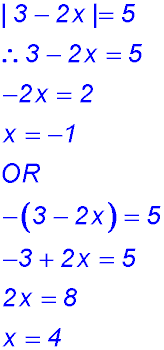 |
5. 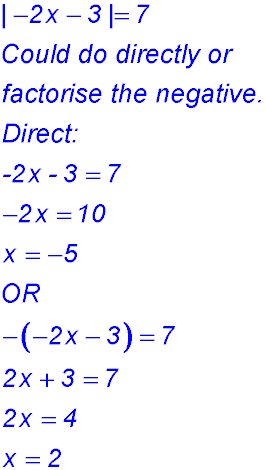 |
|
| 6. | 7. | 8. | |
9. 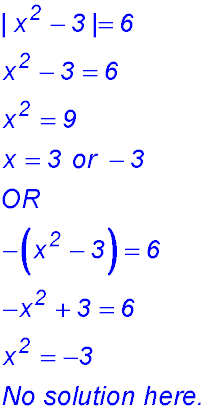 |
10. 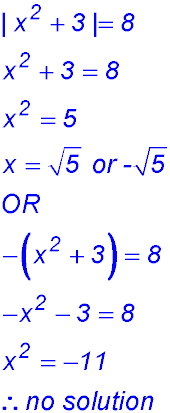 |
11.  |
|
| 2 terms in x | 12. 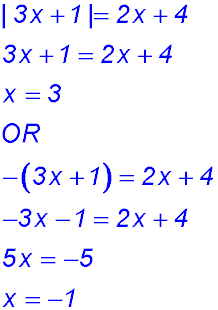 |
13. |
14.
|
| 15. |x - 2| - x = 1
Removing the absolute value signs: x - 2 - x = 1 ∴ -x + 2 - x = 1
2x = 1 |
16. |2x + 6| = |x + 10|
Removing the absolute value signs from both sides: 2x + 6 = x + 10 x = 4 Substitution confirms this answer. Removing the absolute value signs and changing the terms to negative on the RHS:: 2x + 6 = -( x + 10) 2x + 6 = -x - 10 3x = -16 x = -16/3 Substitution confirms this answer. |
17. 2|x + 8| = 3 |x + 5|
Removing the absolute value signs from both sides: 2x + 16 = 3x + 15 x = 1 Substitution confirms this answer. Removing the absolute value signs and changing the terms to negative on the RHS: 2x + 16 = -3x - 15 5x = -31 x = -31/5 or -6.2 Substitution confirms this answer.
|
|
| 18. |6x - 7| = 2|4 - 2x|
Removing the absolute value signs from both sides: 6x - 7 = 8 - 4x 10x = 15 x = 1.5 Substitution confirms this answer. Removing the absolute value signs and changing the terms to negative on the RHS: 6x - 7 = -8 + 4x 2x = -1 x = -0.5 Substitution confirms this answer. |
19.
6|x + 3| - 2|x + 1| = 0 Removing the absolute value signs from both terms: 6x + 18 - 2x - 2 = 0 4x = -16 x = -4 Substitution confirms this answer. Removing the absolute value signs and changing the 2nd term to negative: 6x + 18 + 2x + 2 = 0 8x = -20 x = -5/2 or - 2.5 Substitution confirms this answer. |
20.  |
|
21. 
Multiply both sides by (x + 8): |x + 3| = -3(x + 8) Removing the absolute value signs from the LHS and expanding: x + 3 = -3x - 24 4x = -27 x = -27/4 or -6.75 Removing the absolute value signs and changing the LHS term to negative: -x - 3 = -3x - 24 2x = -21 x = -10.5 Substitution confirms both answers. |
22. 
Multiply both sides by |x - 1|: 4 - x = 2|x - 1| Removing the absolute value signs from the RHS and expanding: 4 - x = 2x - 2 3x = 6 x = 2 Substitution confirms this answer. Removing the absolute value signs and changing the RHS term to negative: 4 - x = -2x + 2 x = -2 Substitution confirms this answer. |
23. |x2 - 21| = 4x
Removing the absolute value signs from the LHS and expanding: x2 - 21 = 4x x2 - 4x - 21 = 0 (x - 7)(x + 3) = 0 x = -7 and +3 Removing the absolute value signs and changing the LHS term to negative: -x2 + 21 = 4x x2 + 4x - 21 = 0 (x + 7)(x - 3) = 0 x = -7 and + 3 Substitution confirms x = 7 but not -7 and |
|
| 24.|x2 + x| = x2 - 3 Removing the absolute value signs from the LHS and expanding: x = -3 Removing the absolute value signs and changing the LHS term to negative: -x2 - x = x2 - 3 2x2 + x - 3 = 0 (2x + 3)(x - 1) = 0 x = -3/2 (or -1.5) and Substitution confirms x = -3 but not -1.5 nor x = 1. |
25.
From this composite graph, it can be seen that the two curves intersect at x = + 2 and at x = -2. |
(iii) 4 - x2 = |x| - 2.
Removing the absolute value sign from the RHS and rearrnaging: x2 + x - 6 = 0 (x + 3))(x - 2) = 0 x = 3 or -2 Substitution confirms x = -2 but not 3. Removing the absolute value signs and changing the RHS term in x to negative: 4 - x2 = -x - 2 x2 - x - 6 = 0 (x - 3)(x -+ 2) = 0 x = -3 or +2 Substitution confirms x = +2 but not -3. So x = ± 2 as from the composite graph. |
|
| 26. | |||
